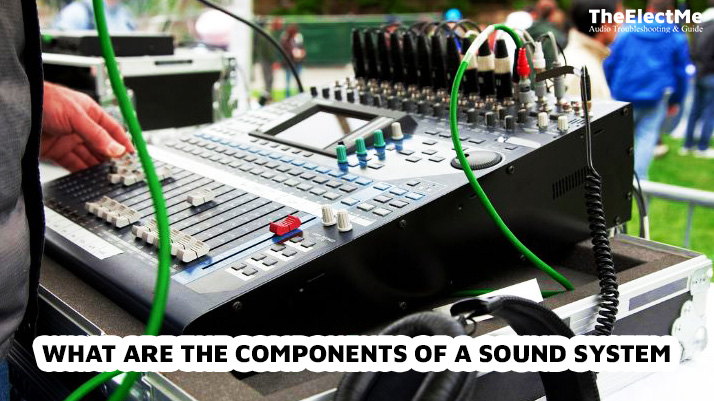What are the components of a sound system? Several key components work together to create a high-quality sound system. From speakers to amplifiers, each element plays a crucial role in delivering clear and powerful audio.
However, not all sound systems are created equal. Depending on your needs and preferences, you may prioritize certain components over others.

So, let’s dive in and explore the key elements that make up a sound system.
What Are The Six Components Of A Sound System?
A typical sound system consists of six primary components – speakers, amplifiers, receivers, equalizers, mixers, and microphones. Each component serves a specific function. Here’s a brief overview of each component and its role in a sound system.
Speakers
Speakers are transducers that turn electrical signals into sound waves, playing audio from sources like music, movies, or speech. The main goal of speakers is to accurately reproduce sound, improving the listening experience for the audience.
When considering speakers for a sound system, two main types stand out for their distinct characteristics and applications:
- Passive Speakers: These speakers require an external amplifier for power and do not have built-in amplification. They are often used in home audio systems or small venues.
- Active Speakers: These speakers have built-in amplification and only require a power source to function. They are commonly used in professional audio setups.
Speaker Specifications
When evaluating speakers, several key specifications play a critical role in determining their performance capabilities:
| Specification | Description |
|---|---|
| Frequency Response | Indicates the range of frequencies a speaker can accurately reproduce, influencing tonal balance and sound quality. |
| Power Handling | Reflects the speaker's ability to manage power effectively, impacting volume output and response to high-energy signals. |
| Impedance | Represents the electrical resistance of the speaker, affecting compatibility with amplifiers and overall efficiency. |
Understanding speaker types and specs helps you pick the best speakers for your sound system. Sometimes the speaker may be blown out. How to fix a blown-out speaker?
Amplifiers
Amplifiers stand as the backbone of any sound system. Amplifiers boost audio signals to levels that drive speakers and produce sound. Amplifiers boost weak audio signals to power speakers efficiently, improving sound quality and clarity.
Amplifier Specifications
When assessing amplifiers, certain key specifications play a crucial role in determining their performance capabilities:
| Specification | Description |
|---|---|
| Wattage | Indicates the power output of the amplifier, influencing the volume and dynamics of the audio produced by the system. |
| Channels | Refers to the number of independent audio signals an amplifier can process simultaneously, affecting sound distribution. |

Mixing Console/Mixer
A mixing console, or mixer, is an electronic device that combines and adjusts audio signals from different sources. It lets users adjust levels, add effects, and mix multiple inputs into a single cohesive output.
A mixing console in a sound system lets users manage audio, balance levels, adjust tones, and control the mix for desired outcomes.
Types of Mixing Consoles
When considering mixing consoles for audio setups, two main types are commonly encountered, each offering unique capabilities:
| Mixing Console Type | Description |
|---|---|
| Analog Mixing Console | Utilizes analogue circuitry to process audio signals, providing a classic, warm sound favoured by some audio enthusiasts. |
| Digital Mixing Console | Operates using digital signal processing technology, offering versatility, precision, and advanced features for audio manipulation. |
Understanding mixers and their features helps pick the right one to improve sound systems, customize audio, and enhance control in projects.
Microphones
Microphones, crucial for capturing audio, convert sound waves into electrical signals for diverse environments and uses.
Microphone Specifications
When choosing microphones for audio recording, key specs impact their performance and suitability for various uses:
| Specification | Description |
|---|---|
| Frequency Response | Defines the range of frequencies a microphone can accurately capture, impacting tonal quality and audio fidelity. |
| Polar Pattern | Indicates the microphone's directional sensitivity, determining how it captures sound from different angles and environments. |
| Sensitivity | Represents the microphone's responsiveness to sound pressure levels, affecting its ability to capture subtle audio nuances. |
Understanding mic types and specs is key to choosing the right ones for your sound system to ensure optimal audio quality. What is the shotgun microphone?

Cables and Connectors
Cables and connectors are crucial for the seamless flow of audio signals between components. Understanding cables, connectors, their types, and roles is essential for strong connections and top sound quality in audio setups.
Cables and connectors are key to sound systems, ensuring clear, reliable audio for superior sound and connectivity.
Types of Cables
When it comes to connecting audio equipment, several types of cables are commonly used, each tailored for specific applications and signal requirements:
- XLR Cable: Known for balanced design, XLR cables are widely used in professional audio for microphones, speakers, and other noise-free audio transmission devices.
- TRS Cable: Tip-Ring-Sleeve (TRS) cables are versatile connectors that can carry balanced audio signals, commonly used for headphones, instruments, and studio equipment.
- RCA Cable: RCA cables are widely used for consumer audio connections, typically found in home entertainment systems, DVD players, and other audiovisual devices.
Understanding cables and connectors boosts sound systems by improving connections, minimizing signal loss, and enabling custom audio setups.
Signal Processing Equipment
Signal processing equipment modifies or enhances audio in real time, letting users customize sounds for specific results. Understanding signal processing equipment types, functions, and uses is key to leveraging them for top-notch sound systems.
Types of Signal Processors
In sound system signal processing, key signal processors are used, each with specific functions to enhance the overall audio processing.
- Equalizers: Equalizers allow users to fine-tune audio by enhancing or reducing specific frequencies, achieving the desired sound.
- Compressors: Compressors balance audio by reducing loud sounds and amplifying quiet ones for consistent volume and peak control.
- Limiters: Limiters protect by keeping audio signals below a set threshold, preventing damage or distortion, and ensuring signal control.
This signal-processing equipment enhances sound quality, customizes audio for clarity, and provides a personalized immersive experience.
Final Thoughts – What Are The Components Of A Sound System?
To sum up, several key components make up a sound system. Each component plays a crucial role in capturing, processing, and distributing audio signals. From the speaker to the mixing console, each component has a unique function and specifications.
Remember, understanding each component’s features and capabilities helps select the right ones for a sound system. With the right components, musicians can create, mix, and distribute high-quality sound.
So, keep exploring and experimenting with different components to create your perfect sound system.



